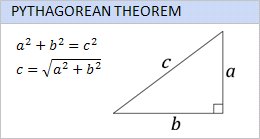 The Pythagorean theorem is a geometry relation amongst the different sides of a right triangle which can be used to calculate one of the missing lengths in a three sided triangle. The theorem is generally credited to the Greek mathematician Pythagoras though this is a debatable fact as many scholars believe this knowledge predated him. This theorem is commonly taught in both junior high and high school math to students studying basic geometry. In simple terms, the Pythagorean theorem states that the sum of the areas of the two small squares equals the area of the big one.
The Pythagorean theorem is a geometry relation amongst the different sides of a right triangle which can be used to calculate one of the missing lengths in a three sided triangle. The theorem is generally credited to the Greek mathematician Pythagoras though this is a debatable fact as many scholars believe this knowledge predated him. This theorem is commonly taught in both junior high and high school math to students studying basic geometry. In simple terms, the Pythagorean theorem states that the sum of the areas of the two small squares equals the area of the big one.
On this page you will find a basic Pythagorean theorem calculator which allows you to input the length of any two sides and it will calculate the missing length of the third side. The Pythagorean theorem formula can be seen in the formula box below.
In this equation, C is the length of the hypotenuse while A and B represent the length of the other two sides. In addition to it’s standard form, this theorem can also be rearranged and solved in other ways to compute any missing side of a right triangle. In the basic form above, you are required to know the length of Side A and the length of Side B, to calculate the length of Side C. However, the formula can be reworked by solving for A or solving for B to create two other corollaries which are able to calculate any missing side, A, B, or C.